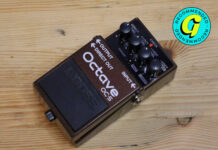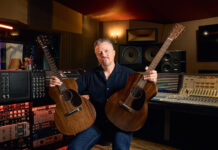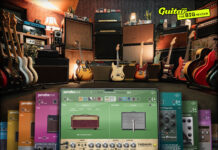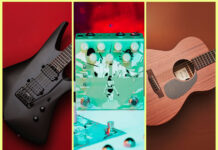
The best guitar amps to buy in 2020: 12 best modelling amplifiers
Digital modelling has, historically, been a controversial topic in the world of guitar. The debate will likely never be over – for every A/B comparison video between a modelling amp and the ‘real thing’ (including our own) there will be ten times as many arguments between those championing the ‘warm’ and ‘punchy’ sound of the tube amp, while others mock short-sighted luddites clinging to the sinking ship of analogue signal processing. The fools.
But as technology marches ever-forward, amplifiers which recreate authentic tube tones with ones and zeroes are getting better and better, and offer a number of advantages over their hot-glass counterparts to boot. Some guitarists will never be convinced, but for those who want to take the plunge into the Matrix-esque cyberzone of digitally-powered amp modellers, read on.
Pros and Cons
There are some pretty obvious advantages to digital modellers. They tend to be lighter, meaning easier transport to gigs (remember gigs?), and can often take a few more hard knocks. Depending on their age and how you use them, tube amps can sometimes require fairly regular maintenance.
Modellers also offer a great number of advantages for practical home use. Sure, that 100 watt head running into a 6×15 cabinet sounds great, but to get it sounding at its best you risk a noise complaint from your entire postcode. A great appeal of modellers is their volume-independent performance, especially pertinent in a time when home-recording is practically essential.
And, especially if you’re just starting out, the sheer number of onboard effects bundled with most modelling amps is another benefit – getting a feel for basic phaser, chorus and delay sounds might let you figure out which stompboxes you want to get in the future, or replace the need for a pedalboard entirely.
Modelling amps, of course, aren’t without downsides. As much as tubes can fail, you don’t usually need an amp tech to replace them. If a complex digital modeller fails, the likelihood is it’ll only be revived by returning it to its manufacturer – and that’s not much use in front of a live audience (remember those?).
What to look for?
If you are shopping for your first modelling amp, you’ll have to learn a whole different language. Impulse response is a common term, referring to how a cabinet, microphone, room or combination thereof affect a sound source. In the context of modelling amps, IRs are used to achieve a realistic sense of space and the sensation of a real cabinet moving air when running directly into a mixer or interface.
Support for third-party impulse responses means you can load in IRs you find online, or ones you create yourself – which could be a dealbreaker for you, if you’re looking to recreate the sound of a certain rig.
Wattage also has a different implication when it comes to solid-state power-amps. The perceived volume per tube watt is much greater than its transistor counterpart. For example, to get a similar volume to the 22-watt original, the Fender Tone Master Deluxe Reverb has to put a whole 100 watts to work.
And when it comes to form factor, there’s a wider spectrum than the common combo/head dichotomy found with valve amps. Some modellers are visually indistinguishable from traditional amps, while others are complex rack units adorned with screens and buttons and others were designed for your bookshelf or coffee table.
The best modelling amps to buy in 2020 at a glance:
Fender Tone Master Deluxe Reverb
Blackstar Silverline Stereo Deluxe
Kemper Profiler
Fractal Axe-Fx III
Vox Valvetronix VT20X
Marshall CODE100
Blackstar ID:Core Stereo 100
Vox Cambridge 50
Yamaha THR10 II Wireless
Fender Mustang GTX100
Boss Katana 50 MK II
Line 6 HX Stomp
Fender Tone Master Deluxe Reverb
Image: Fender+ Incredibly authentic Deluxe Reverb tones
+ Very lightweight
+ Adjustable power rating
– No cheaper than a good tube amp
A testament to the modelling power on display here is our comparison between the Tone Master Deluxe Reverb and an original ’65 Deluxe Reverb. It proved to sound much closer to the Fender original than anyone anticipated, with the Tone Master series offering some of the closest digital emulations of the vintage valve-amp experience than ever before.
The Tone Master Deluxe can also be seen as a flagship for the straightforward application of digital horsepower. There’s no screen, no bank of presets and no Bluetooth connectivity – just plug in and play as you would on a traditional amplifier. The adjustable power rating means you can bring the Tone Master Deluxe Reverb down to acceptable volume levels with ease.
Read our full review here.
Price: £869/$899 Type: Digital modelling combo Channels: 2 Power Rating: 100W (Switchable to 0.2W) Speakers: 1×12” Jensen N-12K Neo Effects: Reverb, tremolo
Blackstar Silverline Stereo Deluxe
Image: Blackstar+ Valve-like punch
+ Immersive stereo effects
+ User definable presets
– Foot controller not included
Similarly, the Blackstar Silvertline Stereo Deluxe packs DSP power into an unassuming amp combo housing. Its feel and response very much nails that of valves, so in that respect it does what many want from a modeller of this ilk to do.
The stereo features are the icing on the cake, with some inspiring, immersive effects on offer – all of the ping-ponging ambient reverb and delay tones to kickstart your next solo project.
Read our full review here.
Price: £749/$849.99 Type: Digital combo w/ 6 voicings Channels: 1 Power Rating: 2x100W Speakers: 2×12″ Celestion V-Type Effects: Modulation (Phaser, flanger, chorus, tremolo) Delay (Linear, analogue, tape, multi), Reverb (Room, hall, spring, plate) Presets: 128
Kemper Profiler
Image: Kemper+ Modelling on your terms
+ Versatile for gigging, practising or recording
+ Infinitely expandable
– Premium system; costly
Here’s where things get complicated. The Kemper Profiler is extremely innovative, allowing you to load in a bunch of classic amp tones – all of which are created by profiling the real thing. You can, of course, profile your own amplifiers, so if your goal with modelling is to convert your extensive tube amp rig into something more portable, this is probably your best bet.
Read our full review here.
Price: £1542/$2,800 Type: Digital modelling unit Channels: 1 Power Rating: 600W Speakers: N/A Amp Models: 200 Other Features: 8-band graphic EQ, 4-band parametric EQ
Fractal Axe-Fx III
Image: Fractal+ Ultra versatile
+ Invaluable studio tool
+ Can be expanded upon with online downloads
– Price of entry is high
The Axe-FX III from Fractal Audio Systems flexes a similar amount of digital power as its rival Kemper. This latest version comes with three times as much processing power as version two, and endless amounts of digital amplifier and effects models. It’s of course expandable with models downloaded from the internet, meaning your only real concern when looking for the right sound is option paralysis.
It’s not for everyone, though, as its rackmount form factor appeals more to a home-studio build than a touring rig.
Read our full review here.
Price: €2,899/$1,999 Type: Digital modelling unit Channels: 1 Power Rating: N/A Speakers: N/A
Marshall CODE100
Image: Marshall+ Great selection of tones
+ Nifty USB interface function
+ Stackable effects
– No substitute for the roar of the real thing
While Marshall is obviously one of the many founding greats of guitar amplification, it didn’t dop its toes into the world of digital modelling for a while. The CODE series offers up a healthy handful of classic Marshall sounds, with 14 preamp models, four power amp models and eight speaker cab simulations. Some extra flavour comes in the form 24 effects. The CODE100 is especially useful in a home studio situation, as its onboard USB connection means it can effectively function as an audio interface for your guitar.
Price: £289/$449.99 Type: Digital modelling combo Channels: 1 Power Rating: 100W Speakers: 2×12” Custom-Designed Marshall CODE Effects: Compressor, distortion, auto-wah, pitch shifter, modulation (chorus, flanger, phaser and tremolo), reverbs, tap tempo delay
Vox Cambridge50
Image: Vox+ Dynamic response
+ Celestion speaker
+ High-quality amp models and effects
– Footswitch not included
Vox’s Virtual Element Technology, found at the core of the Cambridge50, aims to faithfully recreate analogue circuitry. This is helped along by a Korg Nutube-driven preamp section, meaning the immediate feel and response of things is even more responsive that it would be with a fully digital preamp valve emulation. The amp has a varied set of 11 amp models and eight built-in effects, brought to life by a custom Vox-voiced Celestion 12-inch speaker.
Price: £269/$300 Type: Hybrid NuTube modelling combo Channels: 2 x user program Tubes: Nutube 6P1 Power Rating: 50W Speakers: 1×12” Celestion VX12 4 ohms Amp Models: 8 Effects: Modulation (chorus, a flanger, phaser, tremolo), delay (tape, analog), reverb
Yamaha THR10 II Wireless
Image: Yamaha SG+ Impressive sounding
+ Wireless capabilities
+ Battery option
– Hard to gig
Leaning hard into the ‘home-use’ application of digital modelling, the Yamaha THR10 II wireless still has some beefy tones on tap. While it may not be the sort of thing you can gig with, the option to record via USB is a huge bonus, as is the newly introduced capability to sync with a Line 6 GT10 transmitter. Plus, it looks a bit better resting on your coffee table than almost any guitar amp.
Price: £359/$450 Type: Digital desktop combo Channels: 1 Power Rating: 20W (stereo: 2x10W) Speakers: 2×3″
Fender Mustang GTX100
Image: FenderImage: Fender
+ 40 amp models (Fender and third party)
+ Celestion speaker
+ Comprehensive footswitch included
– Complicated UX compared to the Tone Master
If you want a taste of Fender’s modelling amp capabilities, but a bit more versatility that comes with the Tone Masters, the GTX100 has you covered. There are amp models of Fender favourites such as the Blues Jr and Vibro King, as well as a comprehensive set of onboard effects including a 60-second looper.
Price: £419/$500 Type: Modelling combo Channels: 1 Power Rating: 100W Speakers: 1×12” Celestion G12P-80 Amp Models: 40 Effects: Stompboxes, delay, reverb, modulation
Boss Katana-50 MkII
Image: Boss+ Familiar Boss effects
+ Great tones right out of the box
+ Amazing value for money
– Polarising looks
With this second generation of amps, the Boss Katana remains to be one of the most impressive takes on the modelling format around. The on-board amp models give everything from high-gain silliness to restrained vintage crunch a fair shake, and the built-in effects flex Boss’ stompbox mastery to provide everything you really need. The three boost voices also mean an almost endless amount of pushed preamp tones are available, and the available reverb options range from tasteful spring to ambient wash.
Read our full review here.
Watch us compare a 100-watt Boss Katana MkII with a boutique tube combo here.
Price: $230/£237 Type: Modelling combo Power Rating: 50W Speakers: 1×12” Effects: 60 (Boost, modulation, FX, delay, reverb) Amp Types: 5 (double with variation switch)
Blackstar ID:Core 150
Image: Blackstar+ Loud enough to gig
+ Expansive stereo sound
+ Cab-simulated line out
– Deeper editing requires software
With a bit more of a versatile use-case in mind than its Silverline series, the ID:Core 150 still makes use of some neat stereo effects thanks to two 75-watt speakers. There are six amp voices to run through 12 on-board effects, ranging from warm clean tones to a set of higher-gain OD Channels.
If running direct is more your thing, there is a speaker-emulated line out as well as the option to record via USB, however, there isn’t any support for custom impulse responses in this case.
Price: $500/£399 Type: Modelling combo Power Rating: 150W Speakers: 2×10” Effects: 3 (modulation, delay, reverb) Amp Types: 6
Line 6 HX Stomp
Image: Line 6+ Powerful for its size
+ Many I/O options
+ USB connectivity
– Can’t power a regular cabinet
An ultra-portable, pedalboard-friendly unit driven by the same modelling power as found in its bigger Helix sibling, the Line 6 HX Stomps gives you access to a mind-boggling 300 amps, cabs and effects in a unit smaller than some fuzz pedals. These can integrate like a pedal into a bigger rig, or run straight into a DAW or PA. Aside from being a pretty succinct explanation of the benefits of digital modelling in itself, this makes the HX Stomp a great option for a direct travel rig. When it comes to functionality per square-centimetre, the HX Stomp is hard to beat.
Price: $559/£499 Type: Modelling stompbox unit Power Rating: N/A Speakers: N/A Effects and amp types: 300+
For more buyers’ guides, click here.
The post The best guitar amps to buy in 2020: 12 best modelling amplifiers appeared first on Guitar.com | All Things Guitar.
Source: www.guitar-bass.net












